非谓语动词作定语和状语
- 格式:doc
- 大小:98.50 KB
- 文档页数:5
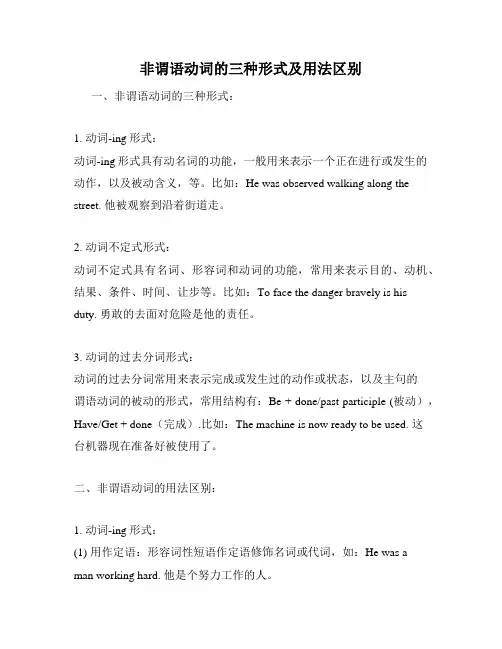
非谓语动词的三种形式及用法区别一、非谓语动词的三种形式:1. 动词-ing形式:动词-ing形式具有动名词的功能,一般用来表示一个正在进行或发生的动作,以及被动含义,等。
比如:He was observed walking along the street. 他被观察到沿着街道走。
2. 动词不定式形式:动词不定式具有名词、形容词和动词的功能,常用来表示目的、动机、结果、条件、时间、让步等。
比如:To face the danger bravely is his duty. 勇敢的去面对危险是他的责任。
3. 动词的过去分词形式:动词的过去分词常用来表示完成或发生过的动作或状态,以及主句的谓语动词的被动的形式,常用结构有:Be + done/past participle (被动),Have/Get + done(完成).比如:The machine is now ready to be used. 这台机器现在准备好被使用了。
二、非谓语动词的用法区别:1. 动词-ing形式:(1) 用作定语:形容词性短语作定语修饰名词或代词,如:He was aman working hard. 他是个努力工作的人。
(2) 用作表语:Ing 形式的短语作表语,表示一个正在进行的动作或状态,如:His job is repairing the machine. 他的工作是修理机器。
2. 动词不定式形式:(1) 作宾补:动词不定式作宾补表示“目的”,“动机”,“结果”,“条件”,“时间”,“让步”等。
如:He came here to do something for us. 他来这里为我们做一些事情。
(2) 作状语:动词不定式作状语,表示“目的”,“动机”,“条件”,“时间”,“让步”等。
如:She always goes out for a walk to relax herself. 她总是出去散步来放松自己。




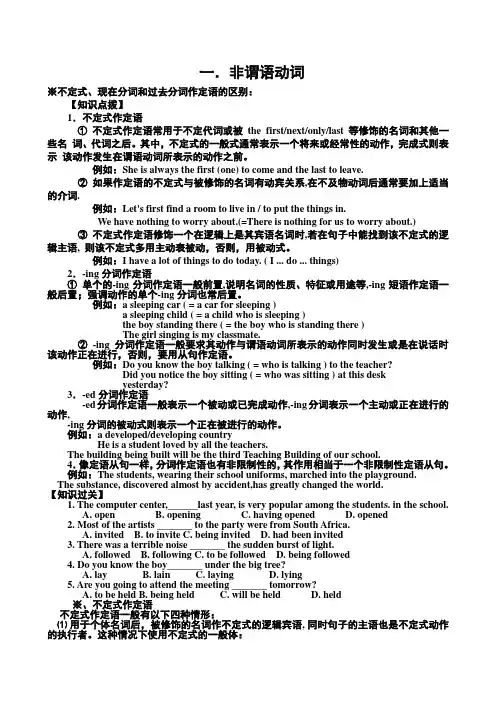
一.非谓语动词※不定式、现在分词和过去分词作定语的区别:【知识点拨】1.不定式作定语①不定式作定语常用于不定代词或被the first/next/only/last等修饰的名词和其他一些名词、代词之后。
其中,不定式的一般式通常表示一个将来或经常性的动作,完成式则表示该动作发生在谓语动词所表示的动作之前。
例如:She is always the first (one) to come and the last to leave.②如果作定语的不定式与被修饰的名词有动宾关系,在不及物动词后通常要加上适当的介词.例如:Let's first find a room to live in / to put the things in.We have nothing to worry about.(=There is nothing for us to worry about.)③不定式作定语修饰一个在逻辑上是其宾语名词时,若在句子中能找到该不定式的逻辑主语, 则该不定式多用主动表被动,否则,用被动式。
例如:I have a lot of things to do today. ( I ... do ... things)2.-ing分词作定语①单个的-ing分词作定语一般前置,说明名词的性质、特征或用途等,-ing短语作定语一般后置;强调动作的单个-ing分词也常后置。
例如:a sleeping car ( = a car for sleeping )a sleeping child ( = a child who is sleeping )the boy standing there ( = the boy who is standing there )The girl singing is my classmate.②-ing分词作定语一般要求其动作与谓语动词所表示的动作同时发生或是在说话时该动作正在进行,否则,要用从句作定语。

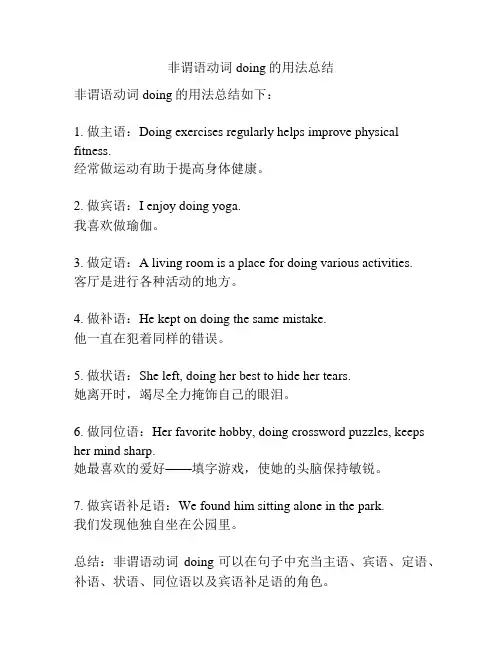
非谓语动词doing的用法总结
非谓语动词doing的用法总结如下:
1. 做主语:Doing exercises regularly helps improve physical fitness.
经常做运动有助于提高身体健康。
2. 做宾语:I enjoy doing yoga.
我喜欢做瑜伽。
3. 做定语:A living room is a place for doing various activities.
客厅是进行各种活动的地方。
4. 做补语:He kept on doing the same mistake.
他一直在犯着同样的错误。
5. 做状语:She left, doing her best to hide her tears.
她离开时,竭尽全力掩饰自己的眼泪。
6. 做同位语:Her favorite hobby, doing crossword puzzles, keeps her mind sharp.
她最喜欢的爱好——填字游戏,使她的头脑保持敏锐。
7. 做宾语补足语:We found him sitting alone in the park.
我们发现他独自坐在公园里。
总结:非谓语动词doing可以在句子中充当主语、宾语、定语、补语、状语、同位语以及宾语补足语的角色。
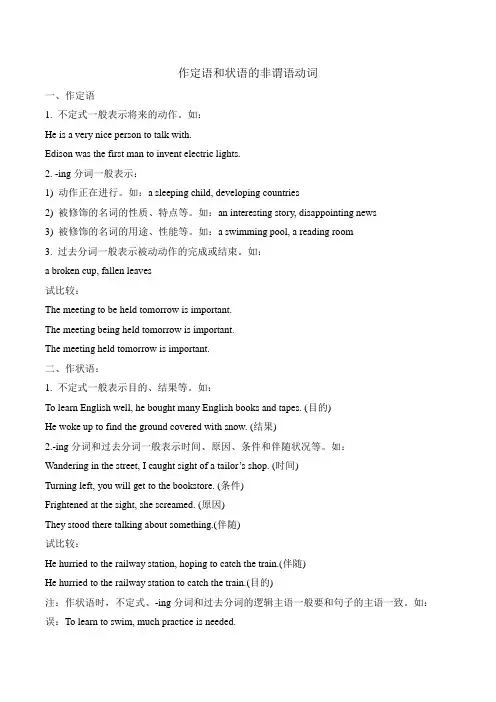
作定语和状语的非谓语动词一、作定语1. 不定式一般表示将来的动作。
如:He is a very nice person to talk with.Edison was the first man to invent electric lights.2. -ing分词一般表示:1) 动作正在进行。
如:a sleeping child, developing countries2) 被修饰的名词的性质、特点等。
如:an interesting story, disappointing news3) 被修饰的名词的用途、性能等。
如:a swimming pool, a reading room3. 过去分词一般表示被动动作的完成或结束。
如:a broken cup, fallen leaves试比较:The meeting to be held tomorrow is important.The meeting being held tomorrow is important.The meeting held tomorrow is important.二、作状语:1. 不定式一般表示目的、结果等。
如:To learn English well, he bought many English books and tapes. (目的)He woke up to find the ground covered with snow. (结果)2.-ing分词和过去分词一般表示时间、原因、条件和伴随状况等。
如:Wandering in the street, I caught sight of a tailor’s shop. (时间)Turning left, you will get to the bookstore. (条件)Frightened at the sight, she screamed. (原因)They stood there talking about something.(伴随)试比较:He hurried to the railway station, hoping to catch the train.(伴随)He hurried to the railway station to catch the train.(目的)注:作状语时,不定式、-ing分词和过去分词的逻辑主语一般要和句子的主语一致。

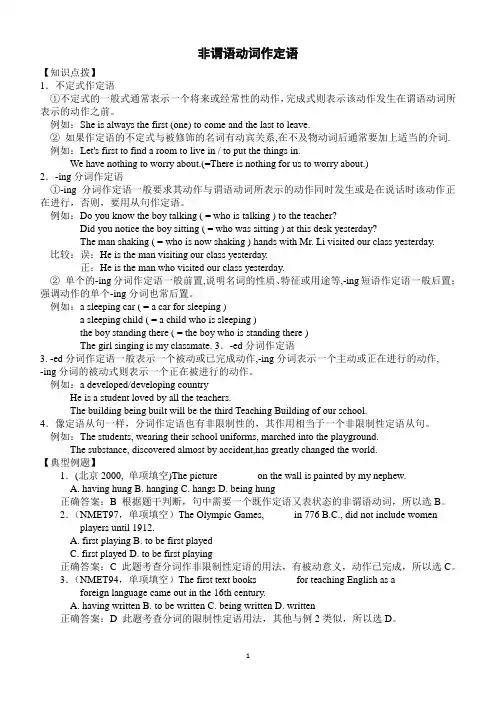
【知识点拨】1.不定式作定语①不定式的一般式通常表示一个将来或经常性的动作,完成式则表示该动作发生在谓语动词所表示的动作之前。
例如:She is always the first (one) to come and the last to leave.②如果作定语的不定式与被修饰的名词有动宾关系,在不及物动词后通常要加上适当的介词.例如:Let's first to find a room to live in / to put the things in.We have nothing to worry about.(=There is nothing for us to worry about.)2.-ing分词作定语①-ing分词作定语一般要求其动作与谓语动词所表示的动作同时发生或是在说话时该动作正在进行,否则,要用从句作定语。
例如:Do you know the boy talking ( = who is talking ) to the teacher?Did you notice the boy sitting ( = who was sitting ) at this desk yesterday?The man shaking ( = who is now shaking ) hands with Mr. Li visited our class yesterday.比较:误:He is the man visiting our class yesterday.正:He is the man who visited our class yesterday.②单个的-ing分词作定语一般前置,说明名词的性质、特征或用途等,-ing短语作定语一般后置;强调动作的单个-ing分词也常后置。
例如:a sleeping car ( = a car for sleeping )a sleeping child ( = a child who is sleeping )the boy standing there ( = the boy who is standing there )The girl singing is my classmate. 3.-ed分词作定语3. -ed分词作定语一般表示一个被动或已完成动作,-ing分词表示一个主动或正在进行的动作,-ing分词的被动式则表示一个正在被进行的动作。
高中英语语法--非谓语动词作定语,状语和补语+练习一、非谓语动词作定语1.基本形式和功能The problem discussed at the last meeting was of great importance.上次会议讨论的问题很重要。
The problem being discussed now is of great importance.现在正在讨论的问题非常重要。
The problem to be discussed at the next meeting is of great importance.下次会议要讨论的问题很重要。
2.ability,chance,idea,fact,attempt,moment,way,right等词后常接不定式作后置定语。
We promise whoever attends the party a chance to have a photo taken with the movie star.我们向参加聚会的人保证有机会和这位电影明星合影。
Do you have the ability to read and write in English?你有英文读写能力吗?二、非谓语动词作状语1.不定式作状语(1)不定式作目的状语也可以构成“so as to do”或“in order to do”的结构。
但so as to do不可置于句首。
不定式作目的状语置于句中时不可用逗号和句子隔开。
Her mother plans to fly to Beijing at least four times a year so as to/in order to visit her.为了看望她,她母亲计划每年至少乘飞机去北京四次。
In order not to forget,Bob wrote down my number.为了不忘记,鲍勃写下了我的号码。
(2)不定式作结果状语。
分词非谓语动词用法总结分词是一种特殊的非谓语动词形式,用来表达被动、完成、进行等不同的语态和时态。
分词非谓语动词在句子中可以作主语、宾语、定语、状语等成分,具有丰富的用法。
本文将总结分词非谓语动词的用法,以帮助读者更好地理解和运用。
一. 分词作定语分词作定语时,一般修饰名词或代词,并与其构成逻辑上的主谓关系,用于修饰、限定名词,起形容词的作用。
例如:1. The running water is very clear.流动的水非常清澈。
2. A baked cake smells delicious.烤熟的蛋糕闻起来很美味。
二. 分词作状语分词作状语时,一般修饰整个句子,表示时间、原因、条件、结果、方式等。
1. 时间状语分词表达动作发生的时间,常用的有现在分词(doing)和过去分词(done)。
例如:Cooking dinner, she accidentally burned her hand.她在做晚饭时不小心烧伤了手。
Exhausted from the long journey, they went straight to bed.他们疲惫不堪地进行了漫长的旅行,直接上床睡觉。
2. 原因状语分词表达动作的原因,常用过去分词形式。
例如:Surprised by the sudden news, he couldn't say a word.受突如其来的消息的惊愕,他说不出话来。
Lost in thoughts, she didn't notice the time passing by.沉浸在思考中,她没有注意到时间的流逝。
3. 条件状语分词表达动作的条件,也常用过去分词形式。
例如:Given the right opportunities, anyone can succeed.给予合适的机会,任何人都能成功。
Without proper training, it's difficult to master a new skill.没有适当的培训,要掌握一项新技能是很困难的。
非谓语动词讲解以及例句非谓语动词是指动词的非谓语形式,不受主语的人称和数的限制,常用作句子的宾语、定语或状语。
非谓语动词包括动名词、不定式和分词三种形式。
一、动名词(-ing形式):1. 作主语:Being kind to others is always a good thing to do.(对他人友善总是值得做的好事。
)2. 作宾语:I enjoy swimming in the ocean.(我喜欢在海里游泳。
)3. 作宾补:She made a decision, ending their relationship.(她做出了一个决定,结束了他们的关系。
)4. 作定语:The running water is so clear and refreshing.(流动的水非常清澈和令人神清气爽。
)5. 作状语:Knowing the answer, he raised his hand.(知道答案后,他举手了。
)二、不定式(to + 动词原形):1. 作主语:To learn a new language is challenging but rewarding.(学习一门新语言是具有挑战性但值得的。
)2. 作宾语:She wants to visit Paris next year.(她想明年去巴黎旅游。
)3. 作宾补:I need to finish this report by tomorrow.(我需要明天之前完成这份报告。
)4. 作定语:He is the best person to ask for help.(他是寻求帮助的最佳人选。
)5. 作状语:She went to the library to study.(她去图书馆学习。
)三、分词:1. 现在分词(-ing形式):The crying baby woke up the entire neighborhood.(哭闹的婴儿吵醒了整个社区。
非谓语动词有哪些什么是非谓语动词
在句子中充当除谓语以外的句子的各种成分的动词形式,叫做非谓语动词。
那么非谓语动词有哪些情况呢?
非谓语动词有哪些
1非谓语动词
非谓语动词有5种情况,分别是动词做主语、动词作宾语、动词作定语、动词作状语、动词作补语,动词作宾语示例:I like watching TV,这就把它变成了ing形式,把它名词化这就叫动词做宾语。
再看动词作定语he is a boy lying under the tree。
lying就是定语修饰boy。
躺在树下的男孩。
再看做状语的。
hearing the news she went crazy。
听到消息她疯了。
听到消息就是一个状态。
hearing the news she went crazy。
这里需要注意的是,从句部分根本不是一个句子,它只是一个动词,所以这个部分呢,我们就要把它叫动词做状语,而不能叫状语从句。
所以非谓语动词一共是5种情况,动词分别做主语、宾语,定语、状语、补语。
2非谓语动词与谓语动词不同点
非谓语动词可以有名词作用(如动词不定式和动名词),在句中做主语、宾语、表语。
非谓语动词可以有形容词作用(如动词不定式和分词),在句中做定语、表语或宾语补足语。
非谓语动词可以有副词作用(如动词不定式和分词),在句中作状语。
谓语动词在句中作谓语,受主语的人称和数的限制;非谓语动词在句中不能单独作谓语,它不受主语的人称和数的限制。
英语中不能单独做句子的谓语。
一.非谓语动词※不定式、现在分词和过去分词作定语的区别:【知识点拨】1.不定式作定语①不定式作定语常用于不定代词或被the first/next/only/last等修饰的名词和其他一些名词、代词之后。
其中,不定式的一般式通常表示一个将来或经常性的动作,完成式则表示该动作发生在谓语动词所表示的动作之前。
例如:She is always the first (one) to come and the last to leave.②如果作定语的不定式与被修饰的名词有动宾关系,在不及物动词后通常要加上适当的介词.例如:Let's first find a room to live in / to put the things in.We have nothing to worry about.(=There is nothing for us to worry about.)③不定式作定语修饰一个在逻辑上是其宾语名词时,若在句子中能找到该不定式的逻辑主语, 则该不定式多用主动表被动,否则,用被动式。
例如:I have a lot of things to do today. ( I ... do ... things)2.-ing分词作定语①单个的-ing分词作定语一般前置,说明名词的性质、特征或用途等,-ing短语作定语一般后置;强调动作的单个-ing分词也常后置。
例如:a sleeping car ( = a car for sleeping )a sleeping child ( = a child who is sleeping )the boy standing there ( = the boy who is standing there )The girl singing is my classmate.② -ing分词作定语一般要求其动作与谓语动词所表示的动作同时发生或是在说话时该动作正在进行,否则,要用从句作定语。
例如:Do you know the boy talking ( = who is talking ) to the teacher?Did you notice the boy sitting ( = who was sitting ) at this deskyesterday?3.-ed分词作定语-ed分词作定语一般表示一个被动或已完成动作,-ing分词表示一个主动或正在进行的动作,-ing分词的被动式则表示一个正在被进行的动作。
例如:a developed/developing countryHe is a student loved by all the teachers.The building being built will be the third Teaching Building of our school.4.像定语从句一样,分词作定语也有非限制性的,其作用相当于一个非限制性定语从句。
例如:The students, wearing their school uniforms, marched into the playground.The substance, discovered almost by accident,has greatly changed the world.【知识过关】1. The computer center,______last year, is very popular among the students. in the school.A. openB. openingC. having openedD. opened2. Most of the artists _______ to the party were from South Africa.A. invitedB. to inviteC. being invitedD. had been invited3. There was a terrible noise _______ the sudden burst of light.A. followedB. followingC. to be followedD. being followed4. Do you know the boy_______ under the big tree?A. layB. lainC. layingD. lying5. Are you going to attend the meeting _______ tomorrow?A. to be heldB. being heldC. will be heldD. held※、不定式作定语不定式作定语一般有以下四种情形:⑴用于个体名词后,被修饰的名词作不定式的逻辑宾语,同时句子的主语也是不定式动作的执行者。
这种情况下使用不定式的一般体:[例题]I can’t find a chair________.A.to sitB.for to sit onC.to sit onD.for sittingI’m not sure which restaurant_______.A.to eat atB.eating atC.to eat onD.for eating⑵用于个体名词后,被修饰的名词作不定式的逻辑宾语,但强调的是不定式动作的执行者、发生的时间或地点时,用不定式一般体的被动形式:例题FIFA has named the36referees for the2012FIFA World Cup_____by South Korea and J apan.A.to be co-hostedB.co-hostedC.being co-hostedD.co-h题What countries do you think will be represented at the six-side peace talk______in Bei jing next month?A.to holdB.holdingC.being heldD.to be held⑶用于个体名词后,和被修饰的名词作不定式的逻辑主语:[例题]She is the first person________the idea.A.think ofB.thinking ofC.to think ofD.thought ofThis report is urgent.We need someone______with the typing.A.helpingB.to helpC.helpedD.to be helped※、现在分词作定语现在分词作定语时,要注意分词所表示动作发生的时间。
大体说来,有下面两种情况:⑴分词表示正在进行的动作,改为定语从句时要用进行时态:[例题]I don`t know the man________over there.A.to standB.standingC.stoodD.being stoodIt seems that I once met with the man_____us.A.servedB.being servedC.to have servedD.serving⑵如果分词和被修饰名词呈现被动关系,而且,所指动作此刻正在发生,或者是和谓语所表示的动作同时发生,就用现在分词一般体的被动形式:[例题]The old man_______has been ill for months.A.to operate onB.operate onC.operatedD.being operated onThe Three Gorge project______now on the middle reaches of Yangtse River is the bigge st dam of its kind.※、过去分词作定语过去分词作定语时,分词表示的动作不仅和所修饰的名词呈被动关系,同时,要么发生于谓语动作之前,要么没有一定的时间性:[例题]From the dates____on the gold coin,we decided that it was made five hundred years ag o.A.markingB.markedC.to be markedD.having been marked[例题]Any applicant form______properly will not be accepted by the company.A.not filledB.not to be filledC.not being filledD.not having been filled[例题]The amount of money_____for the seriously sick child was soon collected.2.-ing分词和-ed分词作状语① -ing分词和-ed分词作状语修饰谓语,多说明动作发生的背景、方式或伴随情况。
如果在逻辑上句中的主语与分词有主谓关系,用-ing分词,有动宾关系则用-ed分词。
例如:We enjoyed ourselves in the park, singing and dancing.Built in 1900, the house is now 100 years old.② -ing分词和-ed分词都可作原因或时间状语, 其作用相当于一个相应的状语从句。
如果在逻辑上句中的主语与分词有主谓关系,用-ing分词,有动宾关系则用-ed分词。
例如:Being so poor in those days, they couldn't send the boy to school.(原因) Born in a poor family, the boy could not go to school. (原因) 3.-ing分词有时可作结果状语。
例如:Her husband died in the war, leaving her a widow with three children.We got up very early, arriving at the hospital ahead of time.4.-ed分词有时用作条件状语,其作用相当于一个条件状语从句。
例如:Given more time, we could have done it much better.【知识过关】1. She set out soon after dark _______ home an hour later.A. arrivingB. to arriveC. having arrivedD. and arrived2. "Can't you read?" Mary said _______ to the notice.A. angrily pointingB. and point angrilyC. angrily pointedD. and angrily pointing3.不定式作原因状语用作原因状语的不定式一般放于句末,偶尔也见于句首。